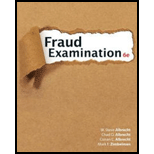
Fraud Examination
6th Edition
ISBN: 9781337619677
Author: Albrecht, W. Steve, Chad O., Conan C., Zimbelman, Mark F.
Publisher: Cengage,
expand_more
expand_more
format_list_bulleted
Concept explainers
Question
Chapter 1, Problem 16MCQ
To determine
The person least likely to be involved in fraud amongst the persons mentioned
Expert Solution & Answer
Want to see the full answer?
Check out a sample textbook solution
Students have asked these similar questions
Solve this
The total cost that would be recorded
Please provide the solution to this financial accounting question with accurate financial calculations.
Chapter 1 Solutions
Fraud Examination
Ch. 1 - Prob. 1DQCh. 1 - Prob. 2DQCh. 1 - Prob. 3DQCh. 1 - Prob. 4DQCh. 1 - Prob. 5DQCh. 1 - Prob. 6DQCh. 1 - Prob. 7DQCh. 1 - Prob. 8DQCh. 1 - Prob. 9DQCh. 1 - Prob. 10DQ
Ch. 1 - Prob. 11DQCh. 1 - Prob. 12DQCh. 1 - Prob. 13DQCh. 1 - Prob. 14DQCh. 1 - Prob. 15DQCh. 1 - Prob. 1TFCh. 1 - Prob. 2TFCh. 1 - Prob. 3TFCh. 1 - 4. Manufacturing companies with a profit margin of...Ch. 1 - Prob. 5TFCh. 1 - Prob. 6TFCh. 1 - 7. When perpetrators are criminally convicted of...Ch. 1 - Prob. 8TFCh. 1 - 9. A Ponzi scheme is considered to be a type of...Ch. 1 - Prob. 10TFCh. 1 - Prob. 11TFCh. 1 - Prob. 12TFCh. 1 - Prob. 14TFCh. 1 - Prob. 15TFCh. 1 - Prob. 16TFCh. 1 - Prob. 17TFCh. 1 - Prob. 18TFCh. 1 - Prob. 19TFCh. 1 - Prob. 20TFCh. 1 - Prob. 21TFCh. 1 - 22. In vendor fraud, customers don’t pay for goods...Ch. 1 - Prob. 23TFCh. 1 - Prob. 24TFCh. 1 - Prob. 25TFCh. 1 - Prob. 26TFCh. 1 - Prob. 27TFCh. 1 - Prob. 28TFCh. 1 - Prob. 29TFCh. 1 - Prob. 30TFCh. 1 - Prob. 1MCQCh. 1 - Prob. 2MCQCh. 1 - Prob. 3MCQCh. 1 - Prob. 4MCQCh. 1 - Prob. 5MCQCh. 1 - Prob. 6MCQCh. 1 - Prob. 7MCQCh. 1 - Prob. 8MCQCh. 1 - Prob. 9MCQCh. 1 - Prob. 10MCQCh. 1 - Prob. 11MCQCh. 1 - Prob. 13MCQCh. 1 - Prob. 14MCQCh. 1 - Prob. 15MCQCh. 1 - Prob. 16MCQCh. 1 - Prob. 17MCQCh. 1 - Prob. 18MCQCh. 1 - Prob. 19MCQCh. 1 - Prob. 20MCQCh. 1 - Which of the following is not an example of...Ch. 1 - Prob. 22MCQCh. 1 - Prob. 23MCQCh. 1 - Prob. 24MCQCh. 1 - Prob. 25MCQCh. 1 - Prob. 1SCCh. 1 - Prob. 2SCCh. 1 - Prob. 3SCCh. 1 - Prob. 4SCCh. 1 - Prob. 5SCCh. 1 - Prob. 6SCCh. 1 - Prob. 7SCCh. 1 - Prob. 8SCCh. 1 - Prob. 9SCCh. 1 - Prob. 10SCCh. 1 - Prob. 11SCCh. 1 - Prob. 13SCCh. 1 - Prob. 14SCCh. 1 - Prob. 15SCCh. 1 - Prob. 16SCCh. 1 - Prob. 1.1CSCh. 1 - Prob. 1.2CSCh. 1 - Prob. 1.3CSCh. 1 - Prob. 2.1CSCh. 1 - Prob. 2.2CSCh. 1 - Prob. 3.1CSCh. 1 - Prob. 3.2CSCh. 1 - Prob. 4.1CSCh. 1 - Prob. 4.2CS
Knowledge Booster
Learn more about
Need a deep-dive on the concept behind this application? Look no further. Learn more about this topic, accounting and related others by exploring similar questions and additional content below.Similar questions
- The amount of overr pr under applied overhead for the month was ?arrow_forwardSolve thisarrow_forwardAnsari Basketball Inc. had a player contract with Rodriguez that is recorded in its books at $3,500,000 on July 15, 2022. Delta Basketball Inc. had a player contract with Williams that is recorded in its books at $4,200,000 on July 15, 2022. On this date, Ansari traded Rodriguez to Delta for Williams and paid a cash difference of $800,000. The fair value of the Williams contract was $5,300,000 on the exchange date. The exchange had no commercial substance. After the exchange, the Williams contract should be recorded in Ansari's books at $ __? Answerarrow_forward
- Pristine Printing's cost formula for its materials cost is $2,150 per month plus $18 per book. For the month of December, the company planned for activity of 725 books, but the actual level of activity was 698 books. The actual materials cost for the month was $14,875. The variance for materials cost in December would be _.arrow_forwardMagnetron Inc. reports a total contribution margin of $135,000 and pretax net income of $27,000 for the current month. The degree of operating leverage is __.arrow_forwardAccurate answerarrow_forward
- Donovan Manufacturing has an overhead application rate of 145% and allocates overhead based on direct material cost. During the current period, direct labor cost is $63,500 and direct materials used cost is $82,000. Determine the amount of overhead Donovan Manufacturing should record in the current period.arrow_forwardPlease provide the accurate answer to this general accounting problem using valid techniques.arrow_forwardAt an output level of 46,000 units, Falstaff Industries calculates that the degree of operating leverage is 2.1. If output rises to 67,850 units, what will be the percentage change in operating cash flow?arrow_forward
arrow_back_ios
SEE MORE QUESTIONS
arrow_forward_ios
Recommended textbooks for you
 Auditing: A Risk Based-Approach (MindTap Course L...AccountingISBN:9781337619455Author:Karla M Johnstone, Audrey A. Gramling, Larry E. RittenbergPublisher:Cengage Learning
Auditing: A Risk Based-Approach (MindTap Course L...AccountingISBN:9781337619455Author:Karla M Johnstone, Audrey A. Gramling, Larry E. RittenbergPublisher:Cengage Learning Managerial Accounting: The Cornerstone of Busines...AccountingISBN:9781337115773Author:Maryanne M. Mowen, Don R. Hansen, Dan L. HeitgerPublisher:Cengage Learning
Managerial Accounting: The Cornerstone of Busines...AccountingISBN:9781337115773Author:Maryanne M. Mowen, Don R. Hansen, Dan L. HeitgerPublisher:Cengage Learning- Principles of Accounting Volume 1AccountingISBN:9781947172685Author:OpenStaxPublisher:OpenStax College
 EBK CONTEMPORARY FINANCIAL MANAGEMENTFinanceISBN:9781337514835Author:MOYERPublisher:CENGAGE LEARNING - CONSIGNMENT
EBK CONTEMPORARY FINANCIAL MANAGEMENTFinanceISBN:9781337514835Author:MOYERPublisher:CENGAGE LEARNING - CONSIGNMENT

Auditing: A Risk Based-Approach (MindTap Course L...
Accounting
ISBN:9781337619455
Author:Karla M Johnstone, Audrey A. Gramling, Larry E. Rittenberg
Publisher:Cengage Learning

Managerial Accounting: The Cornerstone of Busines...
Accounting
ISBN:9781337115773
Author:Maryanne M. Mowen, Don R. Hansen, Dan L. Heitger
Publisher:Cengage Learning


Principles of Accounting Volume 1
Accounting
ISBN:9781947172685
Author:OpenStax
Publisher:OpenStax College

EBK CONTEMPORARY FINANCIAL MANAGEMENT
Finance
ISBN:9781337514835
Author:MOYER
Publisher:CENGAGE LEARNING - CONSIGNMENT